hea th magazine
Bloom into Spring
DOPAMINE: YOUR BRAIN'S NATURAL BOOSTER
BLESS YOU! YOUR ALLERGIES AND YOU
DIVING INTO BETTER HEALTH: HOW YOUR MORNING SWIM HELPS YOU
HOW OUR FURRY FRIENDS KEEP US HEALTHY
ISSUE 31 SPRING 2023
Keeping Skin Healthy, Resilient, Soft & s-MOO-th

SHEA SORBET Intense
Moisturising Vanilla Butter Balm.
SKIN MILK UDDER CREAM
A Restorative Moisturiser to Maintain Skin Health.
FULL CREAM MOISTURISER
A Rich, Hydrating Cream to Quench Skin’s Thirst.
SOOTHING MSM MOISTURISER
A Calming Moisturiser for Sensitive or Irritated Skin.
on page 8. In Dopamine: your brain's natural

With trees growing greener, days growing longer, and flowers bursting into bloom, Spring is finally here! Explore why you're sneezing in the Spring air and how to manage your

booster (page 12) learn about the chemical responsible for keeping you happy. Meanwhile, learn why your pets are helping to keep you healthy on page 27. Finally, check out why athletes swear by a freezing morning swim on page 32.

HEALTH CHECK MAGAZINE | SPRING 2023 3 CONTENTS 29 GREEN THUMBS UP 30 TWIST, DON'T SHOUT! 32 DIVING INTO BETTER HEALTH 35 SLEEPING ON IT 38 MEET OUR TEAM 39 WHAT’S ON AT YOUR BLOOMS THE CHEMIST Disclaimer: All material included in Health Check magazine is provided as general information and is not intended, nor may it be construed, as medical advice or instruction. Information and opinions expressed are believed to be correct and accurate to the best knowledge and judgement of the authors. Readers should consult their appropriately qualified health care professional prior to taking any action or inaction in relation to the content contained herein. HEALTH CHECK MAGAZINE | WINTER 2023 4 ASK A PHARMACIST: URINARY TRACT INFECTIONS 7 PHARMACIST FOCUS 8 BLESS YOU!
ALLERGIES AND YOU 11 A HEALTHY HEART STARTS HERE: BOOK YOUR CHOLESTEROL SCREENING 12 DOPAMINE:
BRAIN'S NATURAL BOOSTER 15 THE CASE FOR YOUR OWN FIRST AID KIT
YOUR
YOUR
allergies
16 WORKING OUT EXERCISE FACT FROM FICTION 20 BRUSH, FLOSS AND RINSE 23 BREATHING EASIER 24 MENTAL HEALTH DISORDERS 27 HOW OUR FURRY FRIENDS KEEP US HEALTHY
by Luke Owen



4
a Pharmacist URINARY TRACT INFECTIONS
Ask
Urinary tract infections (UTIs) are a common condition: about 250,000 Australians develop one each year. More women get them than men, with around half of all women and one in 20 men experiencing a UTI in their lifetime.1
Most infections involve the lower urinary tract - the bladder (causing cystitis) and the urethra (causing urethritis).
The urinary system is designed to minimise the risk of serious infection in the kidneys. It does this by preventing urine from flowing back up into the kidneys from the bladder. Most urinary infections are confined to the bladder and, while causing symptoms, are not severe or life-threatening.
Common symptoms
The symptoms of a UTI can include:
• Wanting to urinate more often and urgently, if only a few drops
• Burning pain or a scalding sensation when urinating
• A feeling that the bladder is still full after urinating
• Pain above the pubic bone
• Cloudy or bloody urine
• Foul or different-smelling urine. However, if the infection reaches the kidneys, prompt medical attention is needed. In addition to the general symptoms of UTIs, a person with a kidney infection can also experience:
• Chills
• Fever
• Lower abdominal pain
• Back pain
• Vomiting.
What causes UTIs?
UTIs typically occur when bacteria enter the urinary tract and begin to spread in the bladder. While our urinary system is designed to keep out bacteria, many bacteria can affect the urethra or bladder. The most common of these is found in our digestive system, Escherichia coli (often just known as E. coli). This can easily spread to the urethra (that tube by which urine leaves the body) and stick to the lining of your urinary system.2
The most common UTIs occur mainly in women and affect the bladder and urethra.
• Bladder infection: This is the most common type of UTI and occurs mainly in women. It's usually caused by E. coli, but sometimes other bacteria are the cause. Women have a higher risk of infection, as in women, the urethra is close to the anus, and the opening of the urethra is close to the bladder. This means having sex can lead to a bladder infection, although you don't have to be sexually active to develop one. This makes it easier for bacteria around the anus to enter the urethra and travel to the bladder.
• Urethral infection: This type of UTI can happen when gut bacteria spread from the anus to the urethra. An infection of the urethra can also be caused by sexually transmitted infections, as women's urethras are close to the vagina.
Some of the ways these bacteria can spread include:
• Through the use of a catheter
• After surgery affecting the area
• Hygiene when wiping after using the toilet (such as wiping from back to front for women)
• Through some types of birth control, such as diaphragms
• When other conditions, such as kidney stones, are present
Am I at risk?
Some groups are more at risk of UTIs than others. This includes:
• Women: Many women experience more than one UTI in their lifetime.3
• Men with prostate problems: An enlarged prostate gland can cause the bladder to only partially empty, raising the risk of infection.
• Older people: Some medications and problems with incontinence mean that older people are more likely to get a UTI. Dehydration is a serious risk for older age groups.
• Infants: Babies in nappies commonly get UTIs.
• Menopause: After menopause, a decline in circulating oestrogen causes changes in the urinary tract. The changes can increase the risk of UTIs.
How can I prevent a UTI?
Some practical tips to lower the risk include:
• Stay hydrated: Drinking plenty of water can help dilute urine and flush out bacteria from the urinary tract.
• Practice good hygiene: Properly cleaning the genital area after using the bathroom, and wiping from front to back, can help prevent the spread of bacteria from the anus to the vagina and urethra.
• Urinate more often: Do not hold in urine for extended periods, as this can allow bacteria to multiply in the bladder.
• Urinate soon after having sex: This can help eliminate any bacteria that may have entered the urinary tract.
• Avoid irritating products: Refrain from using scented soaps, talcum powder, douches, or deodorant around the genital area, as they can irritate the urinary tract.
• Drink cranberry juice: Some research suggests drinking cranberry juice can help prevent UTIs. Ask your healthcare practitioner if this could help you.
How can my Pharmacist help me?
UTIs are often categorised in two ways:
• Uncomplicated: These occur in a structurally and functionally normal urinary tract.
• Complicated: These occur in an abnormal urinary tract or in the presence of other complicating factors.
Some states in Australia are beginning to trial UTI treatment programs in pharmacies, which allows them to diagnose and treat non-complicated UTIs. The availability varies between states and territories but you can search for a local pharmacy offering this service at findapharmacy.com.au/location-search? Visit your local Blooms The Chemist Pharmacist for more information on how to manage and treat your UTI.
1Urinary tract infections: https://kidney.org.au/uploads/resources/KHA-Factsheeturinary-tract-infections-2018.pdf
2Urinary tract infections caused by uropathogenic Escherichia coli strains—new strategies for an old pathogen: https://www.ncbi.nlm.nih.gov/pmc/articles/ PMC9321218/
3Urinary tract infections (UTI): https://www.betterhealth.vic.gov.au/health/ conditionsandtreatments/urinary-tract-infections-uti
HEALTH CHECK MAGAZINE | SPRING 2023 5
Nourish dry skin with Bio-Oil Body Lotion.

Discover the power of oil - but not as you know it. Introducing Bio-Oil Body Lotion. An ultra-light yet high-oil formula that provides sheer, long-lasting moisturisation. Instantly absorbed, it leaves your skin nourished and feeling silky smooth. Shake-up your skincare routine with Bio-Oil Body Lotion.

Ultra-light, yet powerful.
Trademarks are owned by or licensed to the Aspen Group of companies.© 2022 Aspen Group of companies or its licensor. All rights reserved. 6849-091024 NEW
Pharmacist focus
Jack Newbery
 BLOOMS THE CHEMIST KINGAROY
BLOOMS THE CHEMIST KINGAROY
How long have you been a Pharmacist with the Blooms The Chemist network?
I’ve been a Pharmacist for 10 years and have been with Blooms the whole time. I graduated in 2012 and began my internship with Blooms The Chemist Strathpine, where I worked for five years before coming to Kingaroy for the remaining five years.
In that time, some things have changed – we’ve welcomed many new Pharmacists and have rolled out many health services that have helped our customers. Yet some things are exactly the same, like the family feel of our wider Blooms The Chemist network and the willingness to nurture younger Pharmacists like myself. It’s a pleasure to be part of a growing but still welcoming organisation.
What made you want to become a Pharmacist?
I knew I wanted to be in healthcare. Helping people is just how I get my satisfaction. Taking the next step and becoming a Pharmacist-owner is something I did because I was excited to run my own business. It’s helped me learn so much, not just about pharmacy but about myself.
What is the most important thing you've learnt as a Pharmacist?
Listening to people is crucial. Learning to genuinely listen to the person you’re talking to without jumping to conclusions is so important.
How do you relax or spend your free time?
I love being outdoors. Being outside with my family, especially my two kids, is a great pleasure. Spending time working on the garden, going on a short trip to the beach, or checking out a beautiful spot for lunch, is great. Also, working in a shopping centre means I don’t even have a window in my pharmacy, so I appreciate being outside when I can.
What’s the best thing about your community?
There’s a natural small-town feel, and everyone is very welcoming. The relaxed, rural lifestyle is a big help as well. It’s also great that we really know the people we're helping.
How does your pharmacy give back to your local community?
We provide essential health services seven days a week. We’re a rural centre serving people who don’t have time to wait for hospitals to be free, or who may not be able to afford a doctor, and conversations with our Pharmacists don't cost a cent. I’m also proud of our diverse team and how experienced they are in all aspects of life – that life experience is essential when meeting people from all walks of life. What community initiatives do you or your team get involved in?
We're about to embark on a big community initiative, ‘Long drive for drought’, as the official wellness partner. It's a group of around 50 who drive through eight - 10 tiny towns over a week and spend as much as we can. Petrol, food, whatever it is, we try to spend it in these communities. We also do fundraising along the way. We’re going from Goondiwindi to Moree, then back up through channel country to Birdsville.
The main charity we're supporting is Drought Angels; they help farmers through different challenges including drought, flood, grief, or financial stress. Their mission is to provide direct and timely financial assistance, essential resources and meaningful relief for Primary Producers across Australia impacted by drought and natural disasters.
I’ve had firsthand experience with people in my pharmacy using that service, so supporting that charity helps me feel even more connected to our community.
We also sponsor a local footy team, festivals, rodeos, and shows. Looking ahead, we’ve got plans to set up a team for ‘Relay for Life’. And we love supporting our charity partners, Make-A-Wish Australia and the Gidget Foundation Australia.
How do you support your team?
I think it's incredibly important to acknowledge the efforts of my team, whether that’s shouting a coffee, a team dinner, or just stopping to tell a team member they're doing a good job. We’re also flexible with leave; I'm a big supporter of ensuring our team can prioritise their family and other life commitments. It's worth it to make our team members feel supported and empowered.
Every year, we do a family day – an inclusive day where our team members can bring their kids and families. We often go to the park or a bowls club, where we can set up jumping castles and encourage a pleasant social occasion for both our staff and their loved ones.
What are five things you couldn’t live without?
My family, first and foremost. After that is coffee. Thirdly… I’ll say coffee again. I think number four would be my ute - it helps me spend so much time outdoors and go on adventures with my kids. Lastly, maybe my business, as it’s great to have something to work towards that makes a difference in your community. If I couldn’t say coffee twice, I might say country music, although my team might make fun of me for it!
What's the number one health tip you've learnt over the years?
My number one tip is always to do everything in moderation. It’s great to want to make changes in your life, but if you’re extreme in those changes, it’s hard to keep it up. Make the changes that will last! Also it’s a classic, but drink plenty of water.
Do you have a quote to live by?
There's one on my wall which I'm fond of: "A person who is appreciated will always do more than what is expected.” But in our pharmacy we have a few quotes on our walls, so I have many to pick from.
What are you excited about for the future of your store?
I’m excited about the expanded scope of practice. This means Pharmacists will be given more training and more license to treat a wider range of issues. Being in Queensland, we have access to it earlier than some other states, and our Pharmacists are trained in a variety of areas. We’re more than ready to embrace these changes.
If you could shout out one of your customers, who would it be?
I’ve met some wonderful people in my time as a Pharmacist, so it’s hard to pick one. There’s one person coming to mind – a gentleman who is part of the car club in Kingaroy and works in machinery. He has an incredible collection of vintage cars and trucks. Back in those days, you had to build some of these imported cars literally out of the box they came in, which blows my mind to think about. He’s also a Vietnam War veteran and a passionate part of the Kingaroy community.
HEALTH CHECK MAGAZINE | SPRING 2023 7
Bless you!
Your allergies and you
ALLERGIES CAN CAUSE A WIDE RANGE OF DISCOMFORTING SYMPTOMS AND SOMETIMES SEVERE HEALTH COMPLICATIONS. UNDERSTANDING THE CAUSES, SYMPTOMS, AND TREATMENT OPTIONS MAY HELP YOU BETTER MANAGE THESE COMPLEX IMMUNE RESPONSES.

8
Causes of allergies
Typically, our immune systems protect our bodies by identifying and eliminating harmful substances like bacteria and viruses. However, in those with allergies, the immune system becomes hypersensitive and overreacts to often harmless substances. Things which cause allergies are known as allergens.1
Common allergens include pollen, dust mites, pets, foods, medications, and insect venom. Allergic reactions vary, depending on the allergen and your own particular immune response.2 The most common allergic reactions are:
• Respiratory allergies: These include hay fever and asthma, which cause symptoms like sneezing, congestion, coughing, wheezing, and shortness of breath.
• Skin allergies: Conditions such as eczema are characterised by redness, itching, and swelling of the skin. Other conditions, like nettle rash, often have symptoms such as raised, dry white bumps on the skin.
• Food allergies: Certain foods, such as peanuts and shellfish, can trigger an allergic response in certain people. In extreme cases, it can lead to anaphylaxis - a life-threatening reaction causing breathing difficulties. It's important to distinguish between a food allergy, which is an immune system response, and food intolerances, which are not immune system-related and are less serious.
• Insect sting allergies: Some people develop severe reactions such as swelling, itching, and breathing difficulties after being stung by insects like bees, wasps, or fire ants.
Diagnosing allergies
Typically, diagnosing an allergy involves a combination of medical history assessment, physical examinations, and allergy tests. Skinprick tests, blood tests, and elimination diets are commonly used to identify the specific allergen which is triggering the symptoms.3
Treating allergies
Once diagnosed, managing your allergy is critical to protecting your wellbeing and safety. Avoiding allergens altogether would be best, but it is not always possible. Medications such as antihistamines, nasal sprays, bronchodilators, and topical creams can provide relief. Immunotherapy, or allergy shots, can be recommended for people with severe allergies, and these gradually desensitise the immune system to the allergen over time. If you need allergy treatments, visit your local Blooms The Chemist and chat with our friendly Pharmacists, or shop our online selection of antihistamines, eye drops, anti-itch lotions, and nasal sprays at bloomshtechemist.com.au.
Understanding anaphylaxis
Anaphylaxis is a particularly severe and potentially life-threatening allergic reaction that comes on rapidly and can affect multiple organs in the body. It can be caused by the usual triggers listed above but also by medications such as penicillin or aspirin.
During an anaphylactic reaction, the immune system floods the bloodstream with a huge amount of chemicals, including histamine.4 These cause a sudden and widespread inflammatory response throughout the body.
Symptoms can develop within seconds or minutes after exposure to the allergen and may be life-threatening. Fast medical attention is essential, and injecting epinephrine (adrenaline) through an autoinjector, such as an EpiPen, is crucial to counteract the allergic reaction and stabilise the person. Anaphylaxis is a relatively uncommon response to an allergy.5
Reducing risk
While allergies cannot always be prevented, there are strategies to reduce the risk and severity of the reactions:
• Maintain a clean living environment: Regularly dusting, vacuuming, and minimising exposure to potential allergens such as dust mites or pets may limit the frequency and severity of your reactions.
• Use air purifiers: During allergy seasons, keep windows closed and use air purifiers to filter out pollen and other airborne allergens.
• Check your food: Avoid accidental exposure by carefully reading food labels and informing restaurant staff about food allergies. Take particular care when travelling to other countries where you don't speak the language or in areas where nearby medical access is limited.
• Protect against insects: Wear protective clothing and use insect repellent when spending time outdoors to minimise the risk of insect-sting allergies. Depending on the trigger, this may vary according to the season.
• Remain aware: Stay informed about potential allergens in medications and cosmetics, and read labels carefully. Ensure that your medicinal interventions, such as an EpiPen, are not outdated or left behind.
New advances
As the incidence of allergies increases in the Western world, researchers are exploring new avenues for allergy prevention and treatment. Recent advancements include oral immunotherapy for food allergies, sublingual immunotherapy for respiratory allergies, and novel biologic therapies that target specific molecules involved in allergic reactions.6 These advancements may lead to more targeted and effective allergy management in the future. Researchers are also investigating the role of natural microorganisms in the gut. Studies suggest that an imbalance in gut bacteria may contribute to the development of allergies. Probiotics and prebiotics, which promote a healthy gut, are being studied as potential preventative or treatment therapies.7
Technological advancements have also brought about innovative tools for allergy management. Mobile applications and wearable devices can help track pollen counts and air quality and provide personalised allergy management strategies. These digital tools can help you to proactively manage your allergies and make informed decisions about your environment.
Allergies can vary greatly from person to person, and what works for you may not be as effective for someone else. Continued monitoring and taking a personalised approach to allergy management is key in minimising the impact on allergy sufferers.
If you suspect you have allergies or are experiencing severe allergic reactions, consult a healthcare professional for proper diagnosis and guidance. When properly managed, most allergies shouldn't prevent you from living a fulfilling and healthy life.
1Allergies and hypersensitivities: https://www.healthdirect.gov.au/allergies-and-hyper sensitivities
2What is allergy?: https://allergyfacts.org.au/allergy-anaphylaxis/what-is-allergy
3Allergy testing: https://www.healthdirect.gov.au/allergy-testing
4Whatisanaphylaxis?:https://allergyfacts.org.au/allergy-anaphylaxis/what-is-anaphylaxis
5Anaphylaxis: https://www.health.vic.gov.au/sites/default/files/migrated/files/collections /policies-and-guidelines/1/1306004_anaphylaxis_info_aug13_web---pdf.pdf
6Oral immunotherapy for food allergy frequently asked questions: https://www.allergy. org.au/patients/allergy-treatments/oral-immunotherapy-for-food-allergy
7When it comes to food allergies, trust your gut: https://www.unsw.edu.au/news
/2023/03/when-it-comes-to-food-allergies--trust-your-gut
HEALTH CHECK MAGAZINE | SPRING 2023 9
FEATURES

• JointFlex® Pain Relief Cream is a combination of glucosamine, chondroitin and camphor that has quick and effective penetration




• Different varieties and sizes available
• No Stain, No Grease
• Contains Peppermint and turmeric
• Pleasant fragrance
DIRECTIONS FOR USE
BENEFITS
• Relieves mild joint aches and pains and reduces symptoms of mild arthritis.
• Helps provide lasting relief of mild arthritis and joint pain when used daily

• Reduces mild joint inflammation and helps to enhance joint mobility and flexibility

• Targeted pain relief to relieve muscle aches and pains and relieves muscle tension and stiffness supporting overall muscle health and function

Adults and Children 12 years of age and older: Clean, rinse and dry skin prior to application. Apply generously to painful muscles and joints, gently massaging until the JointFlex® Pain Relief Cream disappears. To help take your pain away, repeat as necessary, but no more than 4 times a day. For optimum benefit, use daily for at least two weeks and continue to use daily thereafter.
PRECAUTIONS/WARNINGS
External use only. Avoid contact with eyes and open wounds. If you have sensitive skin, test this product on a small area of skin before applying it to a large area. If irritation occurs, discontinue use. See pack information for more details. JointFlex® products contain glucosamine sulfate from shellfish and chondroitin sulfate from shark cartilage.
Always read the label and follow directions for use.
10 ®
& EFFECTIVE PENETRATION TARGETED PAIN RELIEF LASTING RELIEF WHEN USED DAILY
QUICK
Arrotex Pharmaceuticals Pty Ltd. 15-17 Chapel Street Cremorne Victoria 3121. Ph 1300 927 769. ABN 33 605 909 911. Copyright © 2023. All rights reserved. www.arrotex.com.au | Created: July 2023.
A healthy heart starts here: book your cholesterol screening
THE INCIDENCE OF HIGH CHOLESTEROL DOUBLES FROM AGES 45-54 AND 55-64. IF YOU'RE IN THIS AGE GROUP, YOU MAY BE CONCERNED ABOUT DEVELOPING HIGH CHOLESTEROL, AND UNDERSTANDING HOW YOU CAN IMPLEMENT LIFESTYLE CHANGES TO SAFEGUARD YOUR FUTURE HEALTH.

What is cholesterol?
Cholesterol is a waxy, fat-like substance found in every cell of the human body. It serves as a building block for hormones, vitamin D, and bile acids, which are essential for fat digestion. The body produces its cholesterol in the liver, and we also get it from eating certain foods. However, cholesterol does not dissolve in the blood, and for transportation, it requires lipoproteins, which are combinations of fat and proteins. Unfortunately, as we age, some of our cholesterol receptors become less active, making high cholesterol a more likely condition.
Types of cholesterol
There are two main types of cholesterol: low-density lipoprotein (LDL) and high-density lipoprotein (HDL):
Too much cholesterol in the bloodstream can harden arteries and promote fatty deposits within these arteries, potentially leading to dangerous blockages and narrowing over time called atherosclerosis.
• Low-density lipoprotein: LDL cholesterol is often referred to as 'bad cholesterol'. This is because elevated levels of LDL can harden arteries and promote fatty deposits within these arteries, potentially leading to dangerous blockages and narrowing over time called atherosclerosis. This buildup narrows the arteries, reducing blood flow and increasing the risk of heart disease and stroke.
• High-density lipoprotein: HDL cholesterol is known as 'good cholesterol' due to its role in carrying excess cholesterol away from the arteries and back to the liver for disposal or recycling. High levels of HDL cholesterol can help protect against heart diseases.
What impacts my cholesterol?
• Diet: Consuming foods high in saturated and trans fats can raise LDL cholesterol levels. A diet rich in fruits, vegetables, whole grains, and healthy fats can positively impact cholesterol levels.
• Physical activity: Regular exercise can boost HDL cholesterol and improve your cardiovascular health, as well as your fitness.
• Weight: Being overweight or obese can lead to increased LDL cholesterol levels and decreased HDL cholesterol.
• Genetics: Some individuals may have a genetic predisposition to higher cholesterol levels.
• Age and gender: Cholesterol levels tend to rise with age, and men typically have higher cholesterol levels than pre-menopausal women. However, after menopause, women's cholesterol levels may increase.
• Smoking and alcohol: Smoking lowers HDL cholesterol, while excessive alcohol consumption can raise triglycerides (a type of fat in the blood) and lead to high cholesterol levels.
The implications of high cholesterol
Having high cholesterol increases your chances of suffering from other conditions, such as high blood pressure, diabetes, and stroke. In order to take care of your health as you age, having your cholesterol checked should become a regular part of your health journey. The actions you take before the age of 45 can help strongly mitigate the likelihood of high cholesterol, but even after that age, there are many ways to help combat your risk.
A healthy heart can start at your local Blooms The Chemist. Book your free cholesterol screening test online or visit your closest store for a quick test with your Pharmacist. This screening includes:
• Advice on lifestyle changes that can reduce your risk or help you better manage your cholesterol
• Service and product recommendations
• Help in managing your high cholesterol.
HEALTH CHECK MAGAZINE | SPRING 2023 11
Dopamine: your brain's natural booster
DOPAMINE, THE BRAIN'S 'FEEL-GOOD CHEMICAL', PLAYS A VITAL ROLE IN THE PURSUIT OF HAPPINESS AND OVERALL WELLBEING. IT INFLUENCES A WIDE RANGE OF RESPONSES, INCLUDING MOTIVATION, PLEASURE, REWARD, AND LEARNING. UNDERSTANDING HOW DOPAMINE WORKS CAN EMPOWER US TO MAKE CONSCIOUS LIFESTYLE CHOICES THAT PROMOTE A BALANCED LIFE.
12
What is dopamine?
Dopamine is a neurotransmitter or 'chemical messenger'. Our brain produces dopamine, which travels along four major pathways into the spaces between nerve cells in the brain, called synapses.1 This process can occur at speeds faster than 320 kilometres per hour! As with many systems in our bodies, you likely won't notice this chemical process unless something is wrong.
How does dopamine work?
Dopamine is important due to its involvement in a wide range of functions within the body. One of its primary roles is in the brain's reward system. When we engage in activities that bring us pleasure or fulfilment, dopamine is released, creating a sense of satisfaction and reinforcing the original behaviour.
This forms the foundation for motivation, causing us to seek out rewarding experiences and pursue goals. In day-to-day life, we experience dopamine when we have sex, laugh, earn money, and even when we get revenge.2 Importantly, dopamine doesn't just affect pleasure responses. As Eric Bowman, a lecturer in psychology and neuroscience, describes:3
"…Imagine passing by a vending machine that offers sweets. If you are motivated by hunger, your attention will be drawn to the machine, and you will become more alert as you approach it."
Beyond pleasure and alertness, dopamine is also essential in cognitive processes such as learning and memory. It helps in forming new neural connections, making it possible to acquire and retain knowledge. Dopamine influences attention; mental skills such as remembering, flexible thinking, and self-control; and decisionmaking. These all enable us to focus on tasks, make choices, and regulate our behaviour.4
Does low dopamine affect mental health?
Low dopamine levels are associated with several mental health conditions. Depression, characterised by persistent sadness, low mood, and loss of interest, has been linked to reduced dopamine activity in certain areas of the brain.5
Since dopamine is essential for experiencing pleasure and motivation, a deficit can contribute to feelings of emptiness and a lack of enjoyment of life. Low dopamine can also lead to decreased motivation and energy levels, resulting in difficulties in initiating and completing tasks.
Low dopamine may impair cognitive function, including problems with memory, attention, and decision-making. Conditions such as ADHD have complicated and unknown causes – but are sometimes treated with dopamine-boosters known as methylphenidates.
Does low dopamine affect physical health?
One notable condition associated with dopamine deficiency is Parkinson's disease, characterised by the degeneration of dopamineproducing neurons in the brain.6 This results in motor problems such as tremors, rigidity, and bradykinesia (slowness of movement). Other movement disorders and motor function impairments may also be influenced by low dopamine levels.
Furthermore, dopamine plays a role in cardiovascular function. It helps regulate heart rate, blood pressure, and overall cardiovascular health, so low dopamine levels may contribute to the risk of cardiovascular disorders.7
Can dopamine cause addiction?
Dopamine is connected with pleasure, and individuals with low dopamine can face a higher risk of developing addictive behaviours, particularly if they seek external sources of pleasure and reward. When we engage in pleasurable activities or consume substances like drugs or alcohol, dopamine is released. This creates a pleasurable
sensation, reinforcing the original behaviour and motivating us to repeat it. In the context of addiction, repeated exposure to addictive substances or behaviours can hijack the brain's reward system.
The initial surge of dopamine leads to intense feelings of euphoria – but with continued use, the brain adapts. As a result, certain people may need higher doses of the substance, or engage in riskier behaviours, to achieve the same effect. This creates a cycle of escalating substance misuse or addictive behaviour.
Environmental cues, such as people, places, or objects associated with substance misuse, can also trigger the release of dopamine and activate memories associated with past substance misuse. These cues can become powerful triggers for cravings and can lead to relapse, even after periods of abstinence.
Can I raise my dopamine levels?
If you're concerned about low dopamine levels, consider these options to improve them as well as your overall health:
• Regular physical activity: This is one of the most effective ways to naturally stimulate the release of dopamine. Aim for at least 30 minutes of moderate to vigorous exercise several times a week. Activities such as jogging, dancing, swimming, or cycling can be enjoyable and will help boost your dopamine levels, improving your mood and fitness.
• A good diet: A balanced and nutritious diet can help. Certain foods can enhance the production of dopamine, so include foods like lean proteins (chicken, turkey, fish), legumes, nuts, seeds, and dairy products in your diet. Additionally, foods that are high in antioxidants, such as fruits and vegetables, can help protect your dopamine-producing neurons.
• Enough sleep: Lack of sleep can disrupt dopamine regulation, leading to imbalances and lower mood. Aim for seven to nine hours of quality sleep each night. Establish a regular sleep schedule by creating a relaxing bedtime routine and ensuring your sleep environment is comfortable and conducive to restful sleep.
• Reducing stress: Mindfulness and meditation techniques can positively impact dopamine levels. They can help reduce stress, increase feelings of wellbeing, and improve focus. Engaging in activities such as deep-breathing exercises, yoga, or meditation, on a regular basis can support healthy dopamine function.
• Joyful activity: Participating in activities which bring you joy and satisfaction can naturally increase your dopamine levels. Do your hobbies, spend time with loved ones, listen to music, or explore your creativity. These pleasurable experiences stimulate the release of dopamine and reinforce feelings of happiness and fulfilment.
• Strong social connections: Your friends and family provide a support system which is essential for dopamine regulation. Having meaningful relationships, and spending time with loved ones, can promote feelings of belonging and happiness. Nurture connections with supportive individuals, participate in social activities and seek emotional support when needed.
1What is dopamine?: https://www.webmd.com/mental-health/what-is-dopamine 2Empathic neural responses are modulated by the perceived fairness of others: https:// www.ncbi.nlm.nih.gov/pmc/articles/PMC2636868/
3Explainer: https://theconversation.com/explainer-what-is-dopamine-and-is-it-to-blame -for-our-addictions-51268
4The role of dopamine in learning, memory, and performance of a water escape task: http://elcenia.com/iamapirate/dopamine.pdf
5Dopamine deficiency: https://my.clevelandclinic.org/health/articles/22588-dopamine -deficiency
6Dopamine and Parkinson's Disease: https://www.ncbi.nlm.nih.gov/books/NBK6271/
7The effects of dopamine agonists on human cardiovascular and sympathetic nervous systems: https://pubmed.ncbi.nlm.nih.gov/3158615/
HEALTH CHECK MAGAZINE | SPRING 2023 13



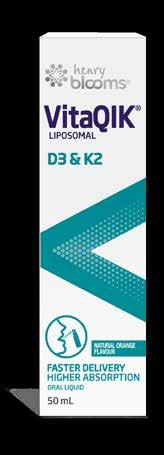
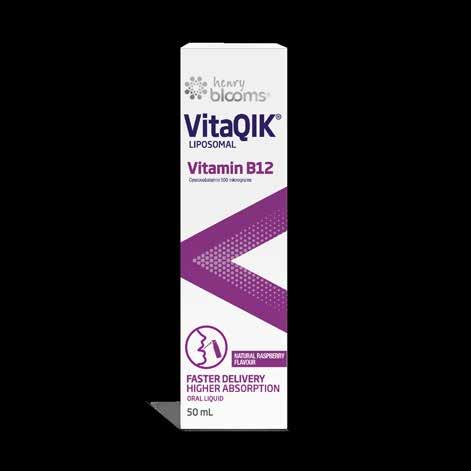
Henry Blooms VitaQIK® Liposomal Vitamin C 50 mL Oral Liquid Supports immune system health Supports bone health ALWAYS READ THE LABEL AND FOLLOW THE DIRECTIONS FOR USE. Supports energy Henry Blooms® VitaQIK® Liposomal Vitamin C 50 mL Oral Liquid, VitaQIK® Liposomal Vitamin B12 50 mL Oral Liquid, VitaQIK® Liposomal D3 & K2 50 mL Oral Liquid ESSENTIALS FOR OPTIMAL HEALTH
The case for your own first aid kit
ACCIDENTS AND EMERGENCIES CAN HAPPEN UNEXPECTEDLY, CATCHING US OFF GUARD. HAVING A WELL-EQUIPPED FIRST AID KIT ON HAND CAN HELP YOU MANAGE MINOR MEDICAL ISSUES IN THE HOME OR ON-THE-GO.

Be prepared
Life is unpredictable, and health emergencies can arise at any time. Whether it's a minor cut or scrape, or a sprain or burn, having a first aid kit close at hand can provide immediate assistance. A wellstocked first aid kit can help reduce the impact of an injury if further medical care is needed. The versatility of a first-aid kit means that if an accident arises when you least expect it, you’ll have the tools on hand to assist the best you can.
Peace of mind
One of the best things about a first aid kit is sometimes simply knowing it’s there. For those who worry about accidents at home, especially parents of young children, having a plan in case of an accident could bring some much-needed peace of mind. The Blooms The Chemist first aid kit contains equipment to treat most at-home incidents, meaning you can rest easier while you watch your young ones jumping from couch to couch. Having the kit there may also help you decide how to react if an accident should happen. Rather than being lost in where to start or who to talk to if there’s an injury, you’ll have a much better idea based on the contents of your first aid kit.
Keeping loved ones clean and healthy
Treating injuries at home means you are unlikely to have the same sterile environment as a hopsital, Doctor's office, or pharmacy consult room. When children are injured, it often involves an accident outside, where dirt may contaminate the injury, or may be exposed to infection through picking at the wound and other lesshygienic habits. Antiseptic wipes are an essential part of a first aid kit, helping to disinfect the area and prevent infection during the healing process. These wipes are an important first defence against infection and can improve chances of recovery. Other tools such as gloves, a face shield, scissors, and tweezers also allow you to take an active role in managing a wound without worrying about contaminating the injury.
Keeping up with every season
You can also adapt and add to your first aid kit based on seasonal illnesses and injuries. For example, during Spring you may wish to stock up on antihistamines and saline spray. During Winter, ensuring you have sore throat lozenges and cough & cold medicine close at hand can reduce the stress of late-night trips to the pharmacy when the bedtime sniffles start. By keeping a well-stocked kit in one place, you (and other carers) will know where to go when faced with any unexpected illnesses or injuries. It's also wise to keep any instruction leaflets on how to use your first aid kit tools and medicines in the same kit or location, so you're fully prepared in case of an emergency.
The Blooms The Chemist first aid kit is an essential healthcare item for the home, car, and workplace. They're also ideal to have on hand for recreational activities, including sports clubs or group activities. Each kit contains key medical supplies including:
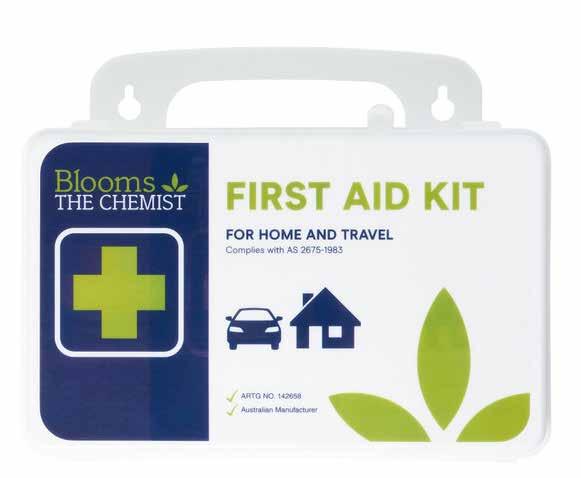
• Bandages and dressings
• Antiseptic wipes and swabs
• A face shield
• Tools including scissors, tweezers, gloves
• Notebook and pen
Pick up your first aid kit in-store or online at bloomsthechemist.com. au/blooms-the-chemist-med-f-aid-kit/
HEALTH CHECK MAGAZINE | SPRING 2023 15
Working out exercise fact from fiction
EXERCISE IS ONE OF THE KEY PILLARS OF OUR HEALTH, SUPPORTING OUR PHYSICAL, MENTAL, AND EMOTIONAL WELLBEING. HOWEVER, THERE ARE MANY FITNESS MYTHS THAT MAY BE DOING MORE HARM THAN GOOD. WE CHALLENGE SOME OF THE MOST COMMON MISUNDERSTANDINGS ABOUT THE IMPACT OF EXERCISE.

16
Myth one: Targeting fat
One of the most persistent myths of the last few decades is the idea that you can spot-reduce or target fat loss in a specific body area. Trainers and weightloss companies have promoted specific techniques or tools that assist with ‘burning’ fat in one area, such as performing crunches to remove weight around the abdomen. However, fat loss occurs in the body as a whole, not in isolated regions.1 When we engage in physical activity, our bodies utilise energy from various sources, including carbohydrates and fats. While exercise does burn calories, the fat reduction is not restricted to the specific area being exercised. Fat loss is a systemic process influenced by factors such as genetics, hormonal balance, and overall energy expenditure.2
Focussing solely on targeting fat overlooks the importance of muscle development and overall body composition. Strength training exercises, for instance, help build lean muscle mass, which increases metabolism and aids in overall fat loss. By incorporating a balanced exercise routine that includes cardiovascular exercises, strength training, and flexibility exercises, individuals can optimise their body composition and improve overall health.
The idea of spot reduction, or losing fat in a specific area through targeted exercise, has been perpetuated by fitness myths. While certain exercises may strengthen and tone specific muscles, they do not lead to fat loss exclusively in those areas.3 The body determines where it stores and burns fat based on individual factors, and no exercise can override this natural process. To achieve sustainable fat loss, it is crucial to adopt a holistic approach that combines regular physical activity with a balanced diet. Engaging in a variety of exercises, including cardiovascular workouts, resistance training, and flexibility exercises, promotes health and contributes to an effective fat loss strategy.
Myth two: Muscle confusion
In the pursuit of fitness and muscle development, the concept of ‘muscle confusion’ has gained popularity in recent years. Advocates claim that constantly changing exercise routines prevents plateaus and promotes continuous muscle growth. However, there’s little research to support this idea and the science behind muscle growth suggests that muscle confusion is unnecessary.4
Muscles are incredible adaptable structures that respond to the stress placed upon them during exercise. When subjected to progressive overload, muscles adapt by becoming stronger and more efficient. While it is important to challenge muscles with varying intensities and exercises, constantly changing routines solely for the sake of ‘muscle confusion’ will most likely be ineffective.
Muscle growth occurs through a process called hypertrophy, which requires consistent stimulation and progressive overload. By consistently performing exercises that target specific muscle groups and gradually increasing intensity or resistance, individuals can achieve muscle growth and strength gains. Using a similar set of exercises allows the body to adapt and optimise this growth. While research suggests occasionally changing exercises may benefit men, constantly changing exercises may hinder progress overall, as the body is not given enough time to experience the necessary stimuli for hypertrophy, potentially leading to suboptimal results.5
Myth three: Women will build too much mass
It's a common misbelief that women who lift weights will automatically bulk up and develop an 'undesirable' amount of muscle mass. However, contrary to popular belief, gaining significant muscle mass requires a combination of intense training, specific nutrition, and, for some, hormonal assistance, over a prolonged period. It does not occur naturally for the majority of women. Regular strength training most often results in a more sculpted and defined physique.6 A balanced exercise routine that includes regular strength training can allow women to achieve a healthy and wellproportioned physique if that is their desire.
Furthermore, most women do not possess the same physiological capacity as men to develop large, bulky muscles easily. The primary reason lies in the hormonal differences between the genders, due to the lower levels of testosterone in women. Testosterone plays a significant role in muscle hypertrophy, and women typically have far lower testosterone levels than men.7 As a result, women are predisposed to develop a more toned and defined physique rather than excessive muscle mass.
Myth four: Exercise compensates for a poor diet
Exercise and nutrition are both crucial components of a healthy lifestyle, but they serve different purposes. Exercise contributes to cardiovascular health, strengthens muscles, improves flexibility, and enhances overall fitness. On the other hand, nutrition provides essential nutrients, fuels the body, supports organ function, and plays a significant role in maintaining a healthy weight. While exercise offers numerous benefits, it cannot fully compensate for an unhealthy diet.
A poor diet that is high in processed foods, added sugars, unhealthy fats, and low in essential nutrients can lead to various health issues. These may include cardiovascular disease, diabetes, or nutrient deficiencies. Exercise alone cannot counteract the negative impact of a consistently unhealthy diet on overall health.8 Good nutrition provides the body with the necessary vitamins, minerals, antioxidants, and macronutrients to support your vitality and wellbeing. No amount of exercise can replace the benefits of a nutrient-rich diet, which are obtained from foods such as fruits, vegetables, whole grains, lean proteins, and healthy fats. The lack of critical vitamins and minerals may have significant implications for your health, even if for instance you’re satisfied with your weight.9
Moreover, weight management is a delicate balance between calorie intake and expenditure. While exercise burns calories, it is much easier to consume excess calories than to burn them off through physical activity alone. Relying solely on exercise to compensate for a poor diet can result in an imbalance and hinder weight loss or maintenance goals.
To achieve optimal fitness and health, it is essential to adopt a balanced approach that combines regular exercise with nutritious diet. If you’re unsure of what that looks like for you, refer to research from trustworthy sources, or consult a qualified healthcare professional.
1Is it possible to target fat loss to specific body parts?: https://www.healthline.com/ nutrition/targeted-weight-loss
2Weight management: https://www.ncbi.nlm.nih.gov/books/NBK221839/
3Effect of abdominal resistance exercise on abdominal subcutaneous fat of obese women: a randomized controlled trial using ultrasound imaging assessments. https:// pubmed.ncbi.nlm.nih.gov/25766455/
4Is muscle confusion real or hype?: https://www.healthline.com/health/exercisefitness/muscle-confusion
5The effects of exercise variation in muscle thickness, maximal strength and motivation in resistance trained men: https://journals.plos.org/plosone/article?id=10.1371/ journal.pone.0226989
6Resistance training health benefits: https://www.betterhealth.vic.gov.au/health/ healthyliving/resistance-training-health-benefits
7Testosterone physiology in resistance exercise and training: https://pubmed.ncbi.nlm. nih.gov/21058750/
8Physical activity, diet quality and all-cause cardiovascular disease and cancer mortality: https://bjsm.bmj.com/content/56/20/1148
9Can you outrun a poor diet?: https://www.sydney.edu.au/news-opinion/news/2022/ 07/12/can-you-outrun-a-poor-diet.html
HEALTH CHECK MAGAZINE | SPRING 2023 17
Control never felt so good
Designed for Men

For Light Incontinence

Protection: Anti-leakage system
Comfort: Fast absorption & dry feeling


Discretion: Controls odour

Only Ellura® contains 36mg PACS, clinically researched to help reduce occurrence of medically diagnosed recurrent cystitis.



HEALTH CHECK MAGAZINE | SPRING 2023 19
Ellura at the counter TESTED & VALIDATED * 36mg PACs I NDEPENDENTLA B
Ask for
Recurrent cystitis? Help stop it before it starts with Ellura
Always Read The Label And Follow The Directions For Use Bianco L et al., J Am Geriatr Soc 2012; 60:1180-1. Uberos J et al., Open Access J of Clinical Trials 2012;4:31-38. Funded by the Carlos III Institute of Health for Clinical Research, Madrid, Spain.
Brush, floss and rinse
MAINTAINING GOOD ORAL HYGIENE IS CRUCIAL FOR A BRIGHT AND CONFIDENT SMILE AND PLAYS A PIVOTAL ROLE IN PROMOTING YOUR WELLBEING. KEEPING YOUR TEETH, MOUTH, AND GUMS HEALTHY SHOULD BE AN ESSENTIAL PART OF YOUR HEALTH JOURNEY, ESPECIALLY IF YOU'RE PRONE TO ORAL DISEASE OR HAVE ORTHODONTIC APPLIANCES (SUCH AS DENTURES OR BRACES).
Neglecting your oral hygiene can lead to a host of oral health problems, including tooth decay, gum disease, and bad breath. However, poor oral health can even extend to the rest of the body, potentially affecting a range of organs.

20
What is plaque?
Plaque is a sticky, colourless film which forms on teeth and along the gumline. When we consume carbohydrates, such as sugars and starches, the bacteria in our mouths feed on these substances and produce acids. These acids, combined with saliva and other elements in our mouth, form plaque.1
Plaque constantly forms on our teeth and, if not removed through proper oral hygiene practices, can lead to health problems. Those acids attack tooth enamel, leading to cavities. If left undisturbed, the plaque may harden, becoming more difficult to remove and requiring professional dental care.
Additionally, if plaque is not removed it can irritate the gums, causing inflammation and gingivitis, the initial stage of gum disease. Over time, if untreated, gum disease can progress to periodontitis, which can result in tooth loss and damage to the surrounding oral tissues.
Avoiding plaque build-up
The best way to stop plaque building up, and to protect your oral health, is by brushing your teeth at least twice a day with fluoride toothpaste and a soft-bristle toothbrush. Brushing after eating is ideal, as it helps prevent food from getting trapped between your teeth and gums for long periods of time.
Many Australians brush their teeth after breakfast and after dinner; however, some also choose to brush after lunch. When brushing, it is crucial to brush along the gumline and cover all tooth surfaces. This should take two to four minutes.
Accessing hard-to-reach areas in your mouth is important, as neglecting these spots may affect your dental health. If you're having difficulty reaching these areas, or if your dentist has advised you to change your brushing technique, you may prefer to use an electric toothbrush. Research suggests that electric toothbrushes are more effective at removing plaque.2
Additionally, flossing daily helps remove plaque and food particles from between teeth and along the gumline, areas that a toothbrush cannot reach effectively. Research has shown that just one month of daily flossing may improve your oral health, while more infrequent flossing will still have many benefits for your teeth.3
Combined, these practices can significantly reduce your risk of tooth decay and gum disease. Visit your local Blooms The Chemist pharmacy to pick up both floss and an electric toothbrush, or chat with our friendly Pharmacists to learn more about oral hygiene.
Related health conditions
Neglecting your oral hygiene can have a disproportionately large impact, since research reveals a strong correlation between oral health and your overall health. Poor oral hygiene can pave the way for bacteria to enter the bloodstream through the gum tissues, causing inflammation and potentially contributing to the development of various health conditions. Studies have shown associations between gum disease and increased risks of cardiovascular disease, diabetes, respiratory infections, and even adverse pregnancy outcomes.4
Moreover, a severely damaged or infected tooth could lead to an abscess, which can have serious consequences. An abscess is a bacterial infection within the tooth or the surrounding gum and bone tissues, typically caused by tooth decay, gum disease, or a dental injury that allows bacteria to penetrate the tooth's inner
layers. Tooth abscesses are painful, but can also lead to tooth decay, ultimately spreading the infection around the body to major organs. In extreme cases this may even lead to severe illness or sepsis, which can result in death, although modern medicine means this is unlikely. Gum disease is also closely linked to poor gut health.5 Harmful bacteria, when swallowed, enter the digestive system and can cause gastrointestinal problems. This can lead to ongoing digestive disorders or systemic inflammation. Inflamed gums are a symptom of gum disease, which can spread throughout the body to your gut –and is associated with conditions such as inflammatory bowel disease (IBD), irritable bowel syndrome (IBS), and gastrointestinal cancers.
Oral health and diet
Oral health is influenced by our dietary choices, too. A diet rich in sugary foods and beverages contributes to tooth decay, as bacteria in the mouth feed on sugar and produce acids that attack tooth enamel. This can be especially problematic if sugary foods are consumed over a long period of time, such as sipping a can of soft drink throughout the day or if teeth aren't brushed until long after consumption. On the other hand, a balanced diet, including fruits, vegetables, and lean meats, provides essential nutrients for strong teeth and gums. Proper nutrition, combined with good oral hygiene practices, creates a solid foundation for our mouth and teeth.6
Dental professionals
Ultimately, the care of dental professionals is pivotal to ensuring you're up to date on your oral hygiene, and regular dental checkups and treatments are an integral part of maintaining optimal oral health. When it comes to oral treatment, early detection is key to preventing further complications.
Professional cleanings by dental hygienists remove hardened plaque (tartar) that cannot be eliminated through brushing and flossing alone. Dentists also perform comprehensive examinations to identify early signs of oral health problems, including cavities, gum disease, oral cancer, and jaw disorders.
Dentists can tell you if seemingly unrelated aspects of your health are, in fact, caused by your oral health. Since the health of our mouths is closely connected to the rest of our bodies, you may also be advised to seek the advice of other professionals, such as an orthodontist or an ear, nose and throat specialist.
Good oral hygiene has a profound impact on our overall wellbeing. A healthy smile boosts self-confidence, promotes positive social interactions, and enhances quality of life. Maintaining fresh breath, healthy teeth, and healthy gums allows us to smile, speak, eat, and engage with others without discomfort or embarrassment, helping us stay happy and healthy.
1What is plaque?: https://www.colgate.com.au/oral-health/plaque-and-tartar/what-isplaque
2A comparison of the efficacy of powered and manual toothbrushes in controlling plaque and gingivitis: https://www.ncbi.nlm.nih.gov/pmc/articles/PMC3652371 3Flossing for the management of periodontal diseases and dental caries in adults: https://pubmed.ncbi.nlm.nih.gov/22161438
4Health mouths: https://www.aihw.gov.au/reports/den/231/oral-health-and-dentalcare-in-australia/contents/healthy-mouths
5The association between oral hygiene and gastric pathologyin patientswith dyspepsia: https://www.ncbi.nlm.nih.gov/pmc/articles/PMC5308132/
6Diet and nutrition: https://www.ada.org.au/Dental-Health-Week-2017/Oral-Healthfor-Busy-Lives/Diet-and-Nutrition.
HEALTH CHECK MAGAZINE | SPRING 2023 21
Sleep well, feel alive.
new Sleep Range supports a good night’s sleep.

Beauty Sleep
• For beautiful skin, supports collagen formation & skin rejuvenation
• With Retinol, Hyaluronic acid, Collagen, Vitamin C and E, Biotin plus Hops
Deep Sleep
• Improves sleep quality
• Relieves restless sleep & helps to wake up refreshed

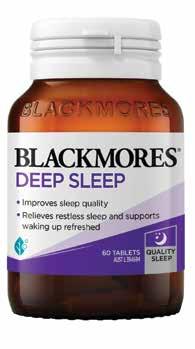
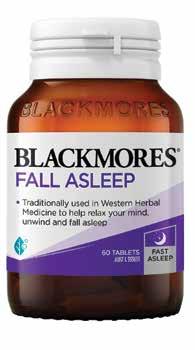
Fall Asleep
• Helps relax your mind, unwind & fall asleep*
• Reduces the time to fall asleep*
*Traditionally used in Western Herbal Medicine.



Good health changes everything
Always read the label and follow the directions for use.
22
Breathing easier
ASTHMA IS A CHRONIC RESPIRATORY CONDITION WHICH AFFECTS MILLIONS OF PEOPLE WORLDWIDE. IT CAN BE A DEBILITATING AND POTENTIALLY LIFE-THREATENING CONDITION, BUT WITH PROPER MANAGEMENT AND CARE, THOSE AFFECTED CAN LEAD ACTIVE AND FULFILLING LIVES.

Asthma is a chronic inflammation of the airways, resulting in recurring episodes of wheezing, shortness of breath, chest tightness, and coughing. These symptoms can vary in severity and frequency from person to person. While asthma cannot be cured, it can be managed effectively through a combination of medication, lifestyle changes, and awareness of triggers.
Medical management
• Professional help: If you suspect you have asthma or if you have been diagnosed, it is crucial to seek medical advice. A healthcare professional, such as a general practitioner or allergist, can provide an accurate diagnosis, prescribe appropriate medications, and create an individualised management plan.1 However, as asthma can present differently between cases and can react differently to treatments, remember that your asthma experience may differ from others.
• Medications: Asthma medications are typically classified into two categories: preventers and relievers. Preventer medications, such as inhaled corticosteroids, help to reduce airway inflammation and prevent asthma symptoms. Reliever medications, usually delivered in a blue or grey inhalation device, provide quick relief during an
asthma attack. They do this by relaxing the airway muscles to open the airways, often working in minutes and lasting up to several hours. It is important to follow the prescribed medication regimen and have regular check-ups with your healthcare provider to adjust treatment as needed.
Lifestyle changes
• Identify and avoid triggers: Asthma triggers can vary from person to person. Common triggers include allergens (such as pollen, dust mites, and pet dander), air pollution, tobacco smoke, exercise, respiratory infections, and stress. Identifying your triggers and taking steps to avoid or limit exposure to them can significantly reduce the frequency and severity of asthma symptoms.2
• Maintain a healthy environment: Keeping your living space clean and free of allergens is essential for managing asthma. Regularly vacuuming, dusting, and washing bedding can help reduce exposure to dust mites and other allergens. Additionally, maintaining good indoor air quality by using air purifiers and ensuring proper ventilation can further improve respiratory health.
• Regular exercise: While physical activity can trigger asthma symptoms in some individuals, it is still important to engage in regular exercise. Talk to your healthcare provider about an exercise plan that works for you, and consider lower-intensity activities such as swimming or walking. Regular exercise can help to strengthen the respiratory muscles and improve overall lung function.
Self-care and techniques
• Proper inhaler technique: Using inhalers correctly is vital for effective medication delivery. Ask your healthcare provider to demonstrate the proper technique and ensure that you understand how to use your inhaler correctly. This will help maximise the benefits of the medication and minimise potential side effects.
• Breathing exercises: Certain breathing exercises, such as diaphragmatic breathing and pursed-lip breathing, can help control asthma symptoms.3 These techniques focus on deep, slow breaths, promoting relaxation, and improved airflow. Incorporating these exercises into your daily routine can enhance lung function and reduce anxiety associated with asthma.
• Asthma action plan: Collaborate with your healthcare provider to create a personalised asthma action plan. This plan should outline steps to take in different scenarios, including when to adjust medication, when to seek emergency care, and how to manage possible asthma attacks. Having a well-defined action plan empowers individuals to respond promptly and effectively during asthma episodes.
By working closely with healthcare professionals, identifying triggers, and adopting a proactive approach to asthma management, you'll be able to react more effectively to asthma attacks, and improve your lung function. As each person's experience with asthma is unique, make sure to personalise your management plan according to your specific needs. With the right strategies in place, asthma can be effectively managed, allowing you to take control of your breathing and life.
1Is it asthma?: https://asthma.org.au/about-asthma/asthma-diagnosis
2The effects of the environment on asthma disease activity: https://www.ncbi.nlm.nih. gov/pmc/articles/PMC6452888
3Would you like to breathe better?: https://asthma.org.au/treatment-diagnosis/live-withasthma/would-you-like-to-breathe-better
HEALTH CHECK MAGAZINE | SPRING 2023 23
Mental health disorders
GLOBALLY, MILLIONS OF PEOPLE LIVE WITH MENTAL HEALTH DISORDERS WHICH CAN PROFOUNDLY IMPACT THEIR WELLBEING AND QUALITY OF LIFE. UNDERSTANDING SOME OF THE MORE PREVALENT MENTAL HEALTH CONDITIONS AND THEIR KEY CHARACTERISTICS, SYMPTOMS, AND TREATMENTS CAN HELP US DEVELOP MORE EMPATHY AND UNDERSTANDING FOR THOSE STRUGGLING WITH A MENTAL HEALTH DISORDER.

24
Depression
Depression is a mood disorder which leads to persistent feelings of sadness, hopelessness, and a loss of interest or pleasure in activities. It often affects the appetite, sleep patterns, energy levels, and ability to concentrate.1 Other symptoms can include feelings of guilt or worthlessness, and even thoughts of self-harm or suicide. While it is normal to experience occasional sadness or downturns, depression is different because of the intensity, duration, and negative impact it has on daily life. Depression is a complex condition with various contributing causes, including family history, brain chemistry imbalances, life events, and personal circumstances.2 It can affect people of all ages and backgrounds, and its impact can range from mild to severe. Treatment for depression frequently involves a combination of psychotherapy, medication, and lifestyle adjustments, such as regular exercise and a healthy diet.
Anxiety
There is a wide range of anxiety disorders, including generalised anxiety disorder (GAD), panic disorder, social anxiety disorder, and specific phobias. Symptoms include excessive and persistent worry, fear, or apprehension, which can be irrational or out of proportion to the situation.
Anxiety can have physical symptoms as well, such as a fast heartbeat, sweating, trembling, shortness of breath, irritability, restlessness, and difficulty concentrating.3 Unlike normal feelings of stress or occasional anxiety, anxiety disorders are long-term and can seriously affect a person's daily life.
As with so many mental health conditions, the causes of anxiety aren't precise. While some may point to a moment or episode in their life that caused symptoms of anxiety, others may develop anxiety for unknown reasons and simply develop anxiety as they grow older. Anxiety is generally understood by healthcare professionals in terms of risk factors. These factors include family history, ongoing stress, issues with physical health, substance use, or different aspects of personality.4 Treatment for anxiety ranges from cognitive or behavioural therapy to medication, stress management such as mindfulness and breathing techniques, and lifestyle changes such as avoiding triggering environments.
Bipolar disorder
Bipolar disorder involves extreme mood swings between manic episodes (feeling on a high) and depressive episodes (feeling very low).
During manic episodes, people may feel more energetic, euphoric, impulsive, and have a lower need for sleep. Depressive episodes, on the other hand, mirror the symptoms of major depression, including persistent sadness, loss of interest, and feelings of worthlessness.
Bipolar disorder can disrupt daily life, strain relationships, and significantly impact overall physical, mental, and emotional health.
Bipolar disorder can be genetically inherited, with a familial link in four out of five cases.5 However, a parent having bipolar disorder does not mean that their child will also develop the condition.
Treatment typically involves a combination of mood-stabilising medication, psychotherapy, and lifestyle adjustments, such as regular sleep patterns and stress-reduction techniques.
Schizophrenia
Schizophrenia is a complex and long-term mental disorder which affects a person's thoughts, emotions, perceptions, and behaviour. Symptoms can include hallucinations (seeing or hearing things that are not there), delusions (believing things that are not true), disorganised thinking, and reduced emotional expression.
People with schizophrenia may also have difficulty processing things, as it can affect their memory and attention span. They may struggle to communicate well:6 they may have trouble organising their thoughts, speak in ways which are hard to follow, and struggle to hold coherent conversations. The exact cause of schizophrenia is still not fully understood, but it is believed to involve a combination of genetic and environmental factors, along with chemicals in the brain.
It often emerges in early adulthood, although it can develop at any age. Treatment for schizophrenia generally involves a combination of antipsychotic medication, psychotherapy, and social support services.
Borderline personality disorder
Borderline personality disorder (BPD) is a complex and challenging mental health disorder. Symptoms include emotional instability, struggles with self-image, overly intense relationships, and impulsive behaviour.
There are many possible causes of BPD, including genetic, environmental, and neurobiological factors. Traumatic experiences, such as childhood abuse or neglect, may contribute to the development of BPD, as well as genetic predispositions and imbalances in brain chemistry.7
Treatment for BPD usually involves a comprehensive approach tailored to the person's needs. Psychotherapy can help people to manage their feelings, while individual and group therapy can provide a supportive environment to explore their emotions, address underlying traumas, and develop healthier coping mechanisms. Medication may be prescribed in some cases to manage specific symptoms; however, this is usually only alongside psychotherapy. Support from a strong network of family, friends, and mental health professionals is crucial.
Overlapping features
Putting a label on a set of symptoms may at first seem helpful, as it might explain things for the patient while also helping clinical professionals provide treatment. However, often there isn't a clear line between conditions. They can overlap, people may have more than one condition at a time, and they may even get different diagnoses from different specialists. For example, depression and anxiety disorders often go hand-inhand, and people can experience symptoms of both at the same time. Similarly, people living with bipolar disorder may struggle with anxiety during their depressive episodes.
This can complicate diagnosis and treatment, requiring a comprehensive approach which addresses all underlying conditions. Integrated treatment plans, including therapy, medication, and support services, are vital in managing these complex cases effectively.
A thorough understanding of the differences between common mental health disorders can help combat the stigma often associated with mental health conditions.
Depression, anxiety disorders, bipolar disorder, and schizophrenia are distinct conditions with unique symptoms and treatment approaches. However, they also share certain overlapping features and a person may experience more than one condition at a time.
It is crucial to seek professional help if you, or someone you know, is experiencing symptoms of a mental health disorder. With increased awareness, empathy, and access to good care, we can support those affected by these conditions and create a more compassionate society. Remember, mental health matters, and no one should face their struggles alone.
If you believe you may have symptoms of a mental health disorder, please see your General Practitioner and visit beyondblue.org.au/ for more information. If you are in crisis or immediate danger, dial 000.
1Depression: https://www.healthdirect.gov.au/depression
2Causes of depression: https://www.beyondblue.org.au/mental-health/depression/ causes-of-depression
3Managing and treating anxiety: https://www.betterhealth.vic.gov.au/health/conditions andtreatments/anxiety-treatment-options
4Anxiety: https://www.healthdirect.gov.au/anxiety
5Bipolar disorder causes: https://www.blackdoginstitute.org.au/resources-support/bipolar -disorder/causes
6Schizophrenia: https://www.betterhealth.vic.gov.au/health/conditionsandtreatments/ schizophrenia
7Borderline personality disorder (BPD): https://www.healthdirect.gov.au/borderlinepersonality-disorder-bpd
HEALTH CHECK MAGAZINE | SPRING 2023 25
The smarter way to connect to your heart health
Your health data is key to your wellbeing. Our Omron Connect app can help you take charge of your health, connect with your doctor, and take action when needed. Stay connected, stay healthy.
STANDARD MEDIUM CUFF Blood Pressure Monitor

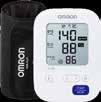

STANDARD M-L CUFF Blood Pressure Monitor

PLUS DUAL USER Blood Pressure Monitor
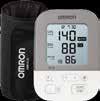
ADVANCED + AFIB
Blood Pressure Monitor HEM7361T


SMART ELITE+ Blood Pressure Monitor

26 Always read the label and follow the directions for use. For people with high blood pressure. Consult your doctor to evaluate the readings. Check your device periodically for accuracy. *Source: “Global Home Appliance Market Comprehensive Survey 2022”, Fuji Keizai Co., Ltd (data for 2021) **IQVIA, National Australian Pharmacy Sell-Out Sales, Blood Pressure Monitors MAT March 2022. * ** AUS/NZ TM
BLOOD PRESSURE MONITORS
Available at
HEM7155T
HEM7156T
PLUS Blood Pressure Monitor
HEM7144T1
HEM7600T
HEM7142T1
How our furry friends keep us healthy
PETS HAVE LONG HELD A SPECIAL PLACE IN OUR HEARTS, PROVIDING COMPANIONSHIP, UNCONDITIONAL LOVE, AND LOYALTY. BUT DID YOU KNOW THAT THEIR POSITIVE INFLUENCE EXTENDS BEYOND EMOTIONAL SUPPORT?

Numerous studies have shown that owning a pet can have remarkable health benefits for their human companions. From reducing stress and anxiety to improving heart health and promoting a more active lifestyle, the healing power of pets is undeniable. Learn about the various ways in which our furry friends positively impact our wellbeing, underscoring the importance of pet ownership for a healthier, happier life.
Emotional support
Life can be overwhelming, and stress has become an increasingly prevalent issue today. However, having a pet can provide a natural antidote to these pressures. Interacting with animals has been shown to lower levels of cortisol, the stress hormone, while increasing the production of serotonin and oxytocin, which contribute to feelings of happiness and relaxation.1
The simple act of petting a dog or stroking a cat has a soothing effect that can alleviate anxiety and promote a sense of calm. Moreover, pets offer unconditional love and companionship, providing a source of emotional support during challenging times. Whether it's a sympathetic ear to listen or a warm presence to cuddle with, pets have an innate ability to boost our emotional wellbeing, reduce feelings of loneliness, and generally improve our mental health.
Keeping you moving
Beyond their positive impact on mental health, pets have tangible benefits for our physical wellbeing. Regular interaction with pets encourages physical activity, as dogs require daily walks and playtime, and cats can engage in interactive play. These activities help us stay active, maintain a healthy weight, and reduce the risk of chronic conditions such as obesity, heart disease, and diabetes. Studies have shown that pet owners tend to have lower blood pressure and cholesterol levels, as well as a reduced risk of heart attacks.2 The presence of a pet can also aid the recovery process
after a medical procedure or illness, as their companionship and affection have been linked to faster healing and improved outcomes.
Social security
Pets are wonderful social facilitators, often serving as a common topic of conversation and a catalyst for building new connections. Taking a dog for a walk or visiting a dog park can provide opportunities for social interaction with fellow pet owners, fostering a sense of community and belonging. For people who may struggle with socialising, having a pet can be particularly beneficial, as it provides a sense of purpose and responsibility. Pets rely on their owners for care, exercise, and attention, which can create structure and routine in our lives, reducing feelings of isolation and giving us a sense of meaning.
Additionally, therapy animals have been proven to have a positive impact on individuals with conditions such as autism spectrum disorders, PTSD, and depression, by providing comfort, emotional support, and promoting socialisation.3
The evidence is clear: pets aren't just delightful companions but also valuable contributors to our health. However, if you are considering bringing a pet into your home, take the time to research different species and breeds to find the right fit for your lifestyle. Whether you choose a dog, cat, bird, or small mammal, the love and companionship they provide will enrich your life in more ways than you can imagine. Embrace the healing power of pets and experience the significant benefits.
1The power of support from companion animals for people living with mental health problems: https://www.ncbi.nlm.nih.gov/pmc/articles/PMC5800290 /
2Pet ownership and cardiovascular risk reduction: https://pubmed.ncbi.nlm.nih.gov
21824172 /
3Pet therapy: https://www.healthline.com/health/pet-therapy
HEALTH CHECK MAGAZINE | SPRING 2023 27




Don’t let a wart spoil their moment! The coldest home wart treatment in Australia for use in children from 4 years.*1-3 Always read the label and follow the directions for use. *Based on IQVIA units sales data and registered products on ARTG as at February 2023 1. In-vitro temp. comparison of cryogenic wart treatment devices. 2016 2. Walczuk I, et al. Dermatol Ther (Heidelb) (2018) 8:203-216. 3. Endwarts Freeze Instructions for use. ENDWARTS® is a Viatris company trade mark. Viatris Pty Ltd. (ABN 29 601 608 771) 30-34 Hickson Road, Millers Point, Sydney NSW. Ph: 1800 314 527 © 2023 Viatris Inc. All rights reserved. Date prepared: April 2023 END-2023-0103
Green thumbs up
SPRING IS A SEASON OF RENEWAL AND GROWTH, MAKING IT THE PERFECT TIME TO GROW A VIBRANT GARDEN IN YOUR BACKYARD. GROWING YOUR OWN FOOD NOT ONLY ALLOWS YOU ACCESS TO FRESH AND NUTRIENT-RICH PRODUCE BUT PROVIDES YOU WITH THE OPPORTUNITY TO RECONNECT WITH NATURE.

Make the most of the sunshine and any fertile soil you have, and grow a variety of healthy foods that can provide numerous health benefits. A homegrown garden may also be a cheaper food source and help you avoid food waste, reducing your environmental impact. Make the most of a compost bin to truly take advantage of your garden bed, and enjoy the benefits of food produced in microbe-rich soil.1
Leafy greens
Spring is a popular time for leafy greens, which are packed with essential vitamins and minerals. Lettuce, spinach, kale, and rocket are excellent choices. These greens thrive in the mild temperatures of Spring and can be harvested continuously, allowing for a constant supply of fresh salads, smoothies, and stir-fries.
Leafy greens are rich in fibre, antioxidants, and folate, promoting healthy digestion, supporting heart health, and providing a range of other benefits. They’re also friendly to beginner gardeners, meaning you shouldn't need a green thumb to enjoy tasty green food after only two or three months of growing.
Herbs
Herbs not only add flavour to your dishes but also offer an array of health benefits. During Spring, herbs like basil, coriander, mint, and parsley flourish in Australia. They're easy to grow and require minimal space. Fresh herbs help your food taste even better, are a rich source of essential nutrients, and can possess medicinal support as they often contain antioxidants.2
Incorporating these fragrant herbs into your cooking can promote digestive health, reduce inflammation, and support your immune system. As well as adding flavour and saving you money, you’re also avoiding single-use waste and microplastics that may come from supermarket purchases.
Tomatoes
Tomatoes thrive in the warm Spring climate of Australia, making them an ideal choice for backyard cultivation. These juicy and versatile fruits are rich in lycopene, a powerful antioxidant known for its potential to reduce the risk of chronic diseases. From cherry tomatoes to grosse lisse varieties, you can choose from a wide range to suit your tastes.
Whether you enjoy them fresh in salads or cooked in sauces, fresh homegrown tomatoes are sure to enhance your cooking. Just be careful – some tomato plants and vines grow extraordinarily quickly, making them difficult to manage if you’re leaving them alone. To avoid this, keep a close eye on your tomato plants, especially as the weather grows warmer.
Berries
Spring heralds the arrival of delicious berries, including strawberries, raspberries, and blueberries. These small, colourful fruits are bursting with vitamins, minerals, and antioxidants. They thrive in Australian backyards during Spring and offer an array of health benefits.
Berries promote brain health, strengthen the immune system, and support cardiovascular health. Their natural sweetness and vibrant flavours make them a perfect addition to smoothies, desserts, or enjoyed on their own as a healthy snack. Strawberries in particular are quite popular for hanging baskets or balcony plants, with the tasty treat at the end an added bonus.
Cruciferous vegetables
Cruciferous vegetables, such as broccoli, cauliflower, and Brussels sprouts, are excellent choices for Spring gardening. These nutrientdense vegetables are high in fibre, vitamins, and minerals while being low in calories. They thrive in cooler Spring temperatures and can be harvested throughout the season. Incorporating cruciferous vegetables into your diet supports detoxification, reduces the risk of chronic diseases, and supports your overall health. Whether steamed, roasted, or stir-fried, these vegetables add a delightful crunch and nutritional value to your meals.
Embrace the season of growth and vitality by growing your own healthy foods in your Australian backyard during Spring. Leafy greens, herbs, tomatoes, berries, and cruciferous vegetables offer an abundance of nutrients, flavours, and health benefits. Cultivating these nutritious foods not only provides you with a sustainable food source but also allows you to savour the freshness and vibrancy of homegrown produce. Remember to nurture your plants with proper care, sunlight, and water to ensure a thriving garden. Enjoy the rewards of your efforts by creating wholesome meals that will nourish your body and delight your taste buds.
1Uncovering how microbes in the soil influence our health and our food: https://www. washingtonpost.com/science/uncovering-how-microbes-in-the-soil-influence-ourhealth-and-our-food/2019/09/27/81634f54-a4ba-11e9-bd56-eac6bb02d01d_story. html
2Herbs: https://www.betterhealth.vic.gov.au/health/healthyliving/herbs
HEALTH CHECK MAGAZINE | SPRING 2023 29
Twist, don't shout!
OUR JOINTS ARE REMARKABLE STRUCTURES THAT ENABLE US TO MOVE, BEND, AND FLEX WITH EASE. THEY SERVE AS VITAL CONNECTORS BETWEEN BONES, PROVIDING STABILITY, SUPPORT, AND A WIDE RANGE OF MOTION. BUT WITH JOINT PAIN AFFECTING MILLIONS OF PEOPLE WORLDWIDE, IT'S IMPORTANT TO UNDERSTAND HOW TO LOOK AFTER OUR JOINTS AND BETTER MANAGE JOINT INFLAMMATION AND DISORDERS.
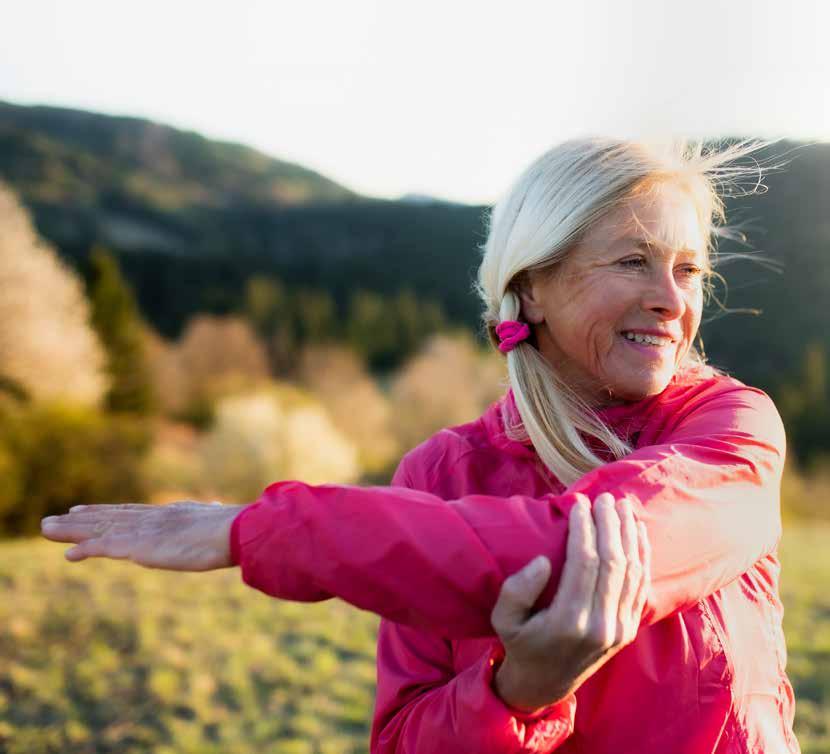
30
Joints are the connections between our bones that allow for movement and flexibility in our bodies. Joint pain can significantly impact quality of life, whether caused by age-related wear and tear, or chronic conditions like arthritis, or sports injuries.
Our most obvious joints are our elbows and knees, but let's not forget our shoulders, fingers, hands, wrists, neck, hips and many more. As the junction where two or more bones meet, joints consist of several core components:1
• Bones: Joints connect bones, allowing them to articulate and move. The ends of the bones that form a joint are covered with a layer of smooth, slippery cartilage, which helps reduce friction and absorb shock during movement.
• Synovial fluid: Within the joint space, synovial fluid lubricates the joint and further reduces friction while nourishing the cartilage.
• Capsule: Surrounding the joint is a fibrous capsule, which provides stability and contains the joint components. The capsule is lined with a thin membrane which secretes synovial fluid.
• Ligaments: Strong bands of connective tissue called ligaments connect bones and provide additional stability for the joint. Ligaments help prevent excessive movement or dislocation.
• Muscles and tendons: Muscles surrounding the joint work in harmony with tendons, which attach muscle to bone. Together, they generate the forces necessary for joint movement and provide support.
These parts of our body work together to create some of the most complicated movements our body can perform. Those different movements include flexion and extension (bending and straightening, respectively), rotating (which creates a turn), or circumduction (which combines these and more motions to create a 'ball-in-socket' movement, such as moving your arm in a circular motion).2
When these joints become inflamed or damaged, they can lead to pain, stiffness, and discomfort. Pain can affect any joint in the body, from the weight-bearing joints like knees and hips to the smaller joints in the hands and feet. Joint pain manifests differently for each person, but common symptoms include:3
• Pain or tenderness in the affected joint(s)
• Swelling or inflammation
• Stiffness or limited range of motion
• Warmth or redness around the joint
• Weakness or instability.
There are two types of joint pain: acute and chronic. While acute joint pain brings rapid swelling and pain, it usually lasts a short time. However, chronic joint pain comes on more slowly, with the swelling and pain lasting long-term and causing ongoing health issues. The pain may come and go at different times of the day, too, so the morning and late evenings can be more painful.
Crucially, the impact of joint pain extends beyond physical discomfort. It can affect our mental and emotional wellbeing, leading to sleep disturbances, fatigue, and overall reduced quality of life. This can be exacerbated if joint pain is impacting one's ability to move around, work, or perform everyday tasks.
Common causes of joint pain include:
• Osteoarthritis: This is the most common cause of joint pain, and it is a degenerative disease which involves the breakdown of cartilage. This condition is commonly associated with ageing and the repetitive use of joints.
• Rheumatoid arthritis: This autoimmune disorder causes the immune system to mistakenly attack the joints, leading to inflammation and joint pain.
• Gout: This is a type of arthritis which occurs when uric acid crystals accumulate in the joints, commonly affecting the big toe. Gout can cause severe pain and inflammation.
• Injuries: Joint pain can also result from acute injuries such as sprains, strains, or fractures. Sports-related injuries or accidents are often the culprits behind joint pain in younger people. One condition, 'tennis elbow', is so called for its frequency in those who play tennis often.4
While joint pain may be challenging, numerous strategies and treatments are available to help people find relief. It is crucial to work with healthcare professionals to develop a personalised plan based on the underlying cause and severity of the joint pain. Here are some effective management techniques:
• Medications: Over-the-counter pain relievers like acetaminophen or non-steroidal anti-inflammatory drugs (NSAIDs) can provide temporary relief. In more severe cases, prescription medications, such as corticosteroids or disease-modifying antirheumatic drugs (DMARDs), may be recommended.
• Physical therapy: A physical therapist can design exercises and stretches to strengthen the muscles around the affected joint, improve flexibility, and reduce pain. They may also incorporate techniques like heat or cold therapy, ultrasound, or electrical stimulation.
• Lifestyle modifications: Maintaining a healthy weight reduces stress on weight-bearing joints. Engaging in low-impact exercises like swimming or cycling can improve joint function without exacerbating pain. Incorporating a balanced diet rich in anti-inflammatory foods, like fruits, vegetables, and fatty fish, can also support joint health.
• Assistive devices: The use of assistive devices such as braces, canes, or orthotic shoe inserts can help alleviate joint pain and improve mobility by providing support and reducing pressure on affected joints.
• Alternative therapies: Some individuals find relief through alternative therapies such as acupuncture, massage, or chiropractic adjustments. While research on their efficacy is mixed, they may be worth exploring with guidance from a healthcare professional.
• Surgery: In severe cases where conservative treatments fail to provide relief, surgical intervention, such as joint replacement or arthroscopy, may be considered.
Joint pain is a common condition which can significantly impact your daily life. Ideally, we need to prevent it from happening, by maintaining a healthy weight, practising proper posture, avoiding repetitive activities that put large amounts of pressure on joints, and using appropriate techniques to protect joints during intense physical activities.
One of the best prevention methods is to engage in regular exercise, which will help keep joints flexible, strengthen the supporting muscles, and boost your fitness. If you're concerned about your joints, consult your healthcare professional for an accurate diagnosis.
1Bones, muscles and joints: https://www.healthdirect.gov.au/bones-muscles-andjoints
2Joints: https://www.betterhealth.vic.gov.au/health/conditionsandtreatments/joints
3Joint pain and swelling: https://www.healthdirect.gov.au/joint-pain-and-swelling
4Tennis elbow: https://www.healthdirect.gov.au/tennis-elbow
HEALTH CHECK MAGAZINE | SPRING 2023 31
Diving into better health

IN THE WORLD OF HEALTH, FEW PROGRAMMES CAN RIVAL THE REMARKABLE ADVANTAGES OF WATER-BASED THERAPY AND EXERCISE. WHETHER YOU'RE GLIDING THROUGH CRYSTAL-CLEAR WATERS IN A TRANQUIL POOL OR ENJOYING THE REFRESHING EMBRACE OF THE OPEN SEA, SWIMMING IS A HOLISTIC ACTIVITY THAT REJUVENATES MIND AND BODY.
Cardiovascular conditioning
Swimming regularly is a fantastic way to enhance your cardiovascular health. Swimming increases your heart rate, improves your circulation, and strengthens your heart muscle. It promotes the efficient delivery of oxygen to your muscles, boosting endurance and overall stamina.1 The continuous motion of swimming also enhances lung capacity, leading to improved respiratory function and increased oxygen intake.
Regular swimming sessions can reduce the risk of cardiovascular diseases, lower blood pressure, and maintain a healthy cholesterol
profile. Meanwhile, exposing your body to cold water stimulates blood circulation, as your blood vessels constrict and then dilate in response to the temperature change.2 This process acts as a workout for your circulatory system, enhancing its efficiency. Improved circulation ensures that oxygen and nutrients are delivered more effectively to your organs, muscles, and tissues, promoting overall health and vitality. Additionally, cold water exposure has been shown to support the immune system by increasing the production of white blood cells, which play a crucial role in fighting off infections and diseases.
32
Rehabilitation and injury prevention
Cold water therapy (known as cryotherapy) has gained popularity for aiding post-workout recovery and reducing inflammation. Athletes and fitness enthusiasts often use ice baths or cold showers – or even ocean dips on a frosty morning – after intense physical activity to soothe their muscles and joints. The cold temperature helps reduce swelling, muscle soreness, and inflammation, accelerating the recovery process.3
Cold water can also be beneficial for those dealing with chronic pain conditions such as arthritis or migraines, providing temporary relief and soothing the discomfort. Similarly, swimming is an excellent choice for individuals recovering from injuries or seeking to prevent them.
Due to its low-impact nature, swimming allows for gentle rehabilitation of injured muscles and joints. Unlike high-impact activities such as running or weightlifting, swimming minimises the pressure on your joints, ligaments, and tendons. The water's buoyancy supports the body, reducing the stress on injured areas and facilitating a quicker recovery.
Swimming also helps improve flexibility and range of motion, preventing future injuries by strengthening the supporting muscles and tendons. This makes it an ideal exercise for individuals with joint pain, arthritis, or injuries.4
Improving physical health
Swimming uniquely engages almost every major muscle group in your body. The natural resistance of water strengthens your muscles without putting excessive strain on your joints. With each stroke, you engage your arms, shoulders, back, chest, and core muscles, promoting balance, endurance, and overall strength. Moreover, the kicking movements work your glutes, quads, hamstrings, and calves, providing a comprehensive full-body workout which few other activities can match.5
Additionally, cold water is a natural tonic for your skin and hair. It also helps tighten and constrict blood vessels, reducing puffiness and inflammation, and giving your skin a firmer and more youthful appearance. Cold water can also promote healthy hair by sealing the hair cuticles, resulting in smoother, shinier locks. It can minimise scalp oiliness and improve hair strength and elasticity. Incorporating cold water rinses at the end of your shower, or splashing your face with cold water, can do wonders for your skin and hair health. Make the most of both of these treatments to feel better than ever, and enjoy the improvement in your fitness and skin health.
Weight management
As a fullbody exercise, swimming can help you burn calories and build lean muscle mass. The resistance provided by water adds intensity to your workout, leading to an increased metabolic rate even after you leave the pool.
Moreover, swimming promotes better body composition by toning your muscles and helping shape your overall appearance. Regular swimming sessions, combined with a balanced diet, can contribute positively to long-term weight management.
Cold water treatment may become an unexpected but valuable tool. When your body is exposed to cold temperatures, it needs to work harder to maintain its core temperature, and so raises your metabolic rate. This leads to a higher calorie burn, even when you're not actively exercising.
Cold water can also activate brown fat, which generates heat by burning calories, aiding your weight loss.6 Incorporating cold water exposure into your routine, such as cold showers or swimming in cool water, can complement your healthy lifestyle choices and support your weight management journey.
Mental wellbeing
Cold water can be a powerful mood booster and an effective remedy for stress, anxiety, and depression. When you immerse your body in cold water, your brain releases endorphins, also known as 'feel-good' hormones, which can induce a sense of euphoria and improve your overall mood.
Cold water exposure has also been linked to increased alertness, mental clarity, and focus.7 It stimulates the release of norepinephrine, a neurotransmitter which plays a role in attention and cognition. Taking a refreshing cold shower in the morning can kick-start your day with a burst of energy and a positive mindset.
Swimming also offers tangible mental and emotional benefits. The rhythmic movement and focus required during swimming can induce a state of relaxation, reducing stress and anxiety levels. The tranquil environment of a pool or the beauty of an open-water swim can have a mindful effect, allowing you to unwind and escape the pressures of daily life. Swimming has been linked to improved mental clarity, enhanced mood, and increased overall happiness. It is often considered a form of therapy, providing a sense of calmness and balance.
Swimming is a powerful and versatile exercise which offers a myriad of benefits for both physical and mental health. Whether you're seeking a full-body workout, cardiovascular conditioning, weight management, or simply a therapeutic escape, swimming has something for everyone. So grab your swimsuit and head to the nearest pool or beach, and let the transformative power of swimming guide you towards a healthier, happier life. Or, embrace the cold water experience and venture into icy waters to unlock a world of revitalisation and wellness.
1Swimming-healthbenefits:https://www.betterhealth.vic.gov.au/health/healthyliving/ swimming-health-benefits
2What to know about cold water therapy: https://www.healthline.com/health/coldwater-therapy
3Health Check: do ice baths after sport help recovery or improve results? https:// theconversation.com/health-check-do-ice-baths-after-sport-help-recovery-orimprove-results-44829
4Health benefits of swimming: https://www.healthdirect.gov.au/health-benefits-ofswimming
5Does swimming build muscle?: https://www.livescience.com/does-swimming-buildmuscle
6Effect of intermittent cold exposure on brown fat activation, obesity, and energy homeostasis in mice: https://www.ncbi.nlm.nih.gov/pmc/articles/PMC3895006/
7Cold showers: a scientist explains if they are as good foryou as Wim Hof (the ‘Iceman’) suggests: https://theconversation.com/cold-showers-a-scientist-explains-if-they-areas-good-for-you-as-wim-hof-the-iceman-suggests-181678
HEALTH CHECK MAGAZINE | SPRING 2023 33

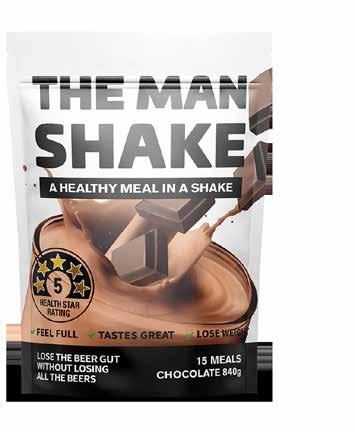

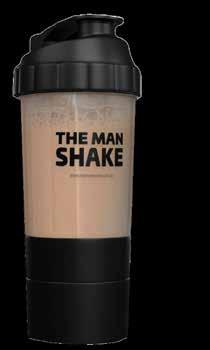
34
Sleeping on it
WITH MANY OF US TRYING TO MEET DEMANDING SCHEDULES AND OBLIGATIONS, WE OFTEN END UP SACRIFICING CRITICAL HOURS OF REST. HOWEVER, FOR SOME OF US, SLEEPLESS NIGHTS MAY NOT BE DUE TO TIME CONSTRAINTS BUT RATHER A POTENTIAL HEALTH CONDITION.
Sleep apnoea is a serious sleep disorder that often goes undiagnosed and untreated, leading to numerous health complications. It can also be frustrating for those sleeping nearby, as snoring is a major symptom of sleep apnoea. Having a partner that snores loudly can harm your sleep hygiene, which can influence your mood, concentration, and even physical health.
What is sleep apnoea?
Sleep apnoea is a chronic sleep disorder characterised by recurring disruptions in your breathing during sleep. These interruptions can last from a few seconds to minutes and happen numerous times throughout the night. There are two main types of sleep apnoea:
• Obstructive Sleep Apnoea (OSA): This is the most common form of sleep apnoea and is caused by a physical blockage or collapse in the airway. When the muscles at the back of your throat relax excessively, the airway becomes obstructed, creating breathing difficulties.
• Central Sleep Apnoea (CSA): Unlike OSA, central sleep apnoea is not caused by a physical blockage. Instead, CSA occurs when breathing pauses throughout the night, often due to issues with the breathing reflex.
Recognising the signs and symptoms
Sleep apnoea symptoms can be subtle and are often overlooked, especially in its early stages. However, awareness of the warning signs can lead to early detection and timely intervention. Some common symptoms of sleep apnoea include:
• Loud and persistent snoring
• Pauses in breathing
• Excessive daytime fatigue
• Morning headaches
• Difficulty concentrating
• Irritability and mood swings
• Dry mouth or sore throat in the morning.
Understanding the risk factors
Certain factors can increase the likelihood of developing sleep apnoea. Some of the most common risk factors include:
• Obesity: Excess weight can contribute to the constriction of the airway, leading to obstructive sleep apnoea.
• Age: Sleep apnoea is more prevalent in older adults.
• Gender: Men are more likely to develop sleep apnoea than women, although the risk for women increases if they are overweight or have reached menopause.
• Family history: If you have family members with sleep apnoea, your risk of developing it may be higher.
• Smoking and alcohol use: Both smoking and excessive alcohol consumption can increase the risk of sleep apnoea.
• Nasal congestion: Individuals with chronic nasal congestion may have a higher risk of obstructive sleep apnoea.
• Medical conditions: Certain medical conditions, such as heart disorders and type 2 diabetes, are associated with an increased risk of sleep apnoea.
Seeking diagnosis and treatment
As a Pharmacist at Blooms The Chemist Mudgee, Laura Rheinberger knows too well the impact sleep apnoea can have on those with the condition and those who share a bedroom with those affected.
“We’ve seen more and more people interested in finding out about sleep apnoea. Often, people asking us about it don’t think they have it but are asking on behalf of a partner or loved one. Being unable to sleep due to a partner’s snoring means you’re getting less sleep too, which can have a clear impact on your overall health.”
Laura recommends taking your sleep hygiene seriously. “Sometimes treating sleep apnoea can be daunting, with some people intimidated by sleeping with a CPAP machine or breathing through their nose. However, there are many forms of treatment, and the impact of poor sleep on your health can’t be overstated.”
If sleep apnoea is left untreated, you may face long-term health consequences. This can include cardiovascular issues, diabetes, daytime accidents, weight gain, and poor mental health.

It’s important to chat to a healthcare professional if you suspect sleep apnoea may be impacting your sleep, whether you or someone you live with who is showing symptoms.
“Your local Blooms The Chemist Pharmacist will be available for a chat. We’d especially encourage anyone who thinks their partner may be suffering from sleep apnoea to talk with our Pharmacists”, Laura advises.
If you think you or a loved one may have sleep apnoea, you may want to take a sleep quiz. This is available on the Blooms the Chemist website at bloomsthechemist.com.au/sleep-quiz/.
HEALTH CHECK MAGAZINE | SPRING 2023 35

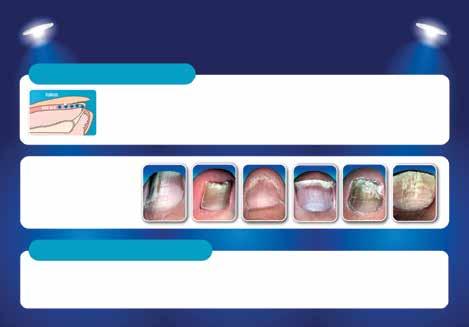
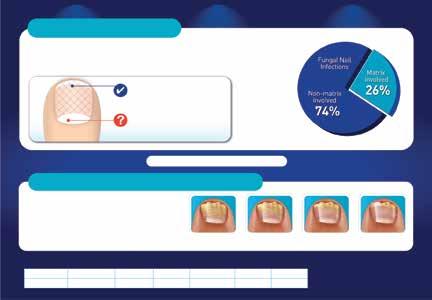



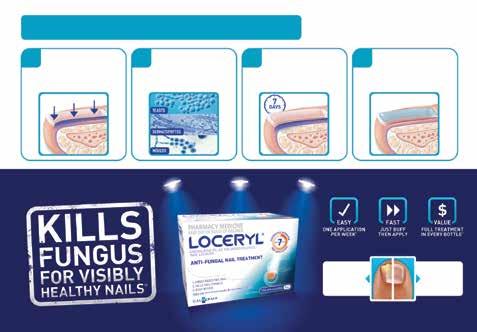















36 HOW DOES LOCERYL TREAT ONYCHOMYCOSIS? 1 WORKS DEEP IN THE NAIL BED 2 FIGHTS ALL NAIL FUNGI 3 LONG LASTING EFFECT infections won’t go away without treatment. 4,5 significant impact on patients’ emotional, social and occupational life. treatment can prevent disease progression to severe onychomycosis.2 • Onychomycosis is a fungal infection of the toenails or fingernails.1 • The infection occurs when the fungus infects the nail bed.1 Unless treated correctly, fungal nail infections may get worse or spread.2 general 2-8%.3 Onychomycosis is to affect million Australians.*,3 ONYCHOMYCOSIS? TREAT ONYCHOMYCOSIS? How to treat onychomycosis? Treatment options depend on the location and extent of the infection. The majority of fungal nail infections are non-matrix involved and are therefore suitable for topical treatment. Estimated onychomycosis treatment time for an infected toenail • Treatment can take 6-12 months as the nail must grow out Manage patient expectations on treatment time 6-12 months HOW DOES LOCERYL TREAT ONYCHOMYCOSIS? 1 WORKS DEEP IN THE NAIL BED 2 FIGHTS ALL NAIL FUNGI 3 LONG LASTING EFFECT LOCERYL® to get to the site of the infection 1. HOW DOES LOCERYL OF FUNGUS KILLING ACTION FOR UP TO 7 DAYS ONCE A WEEK APPLICATION* EASY *Or 2 applications/week. With each application. ˆFor 1-2 nails for up to 12 months. non-matrix
infection
for topical treatment (eg. Loceryl®) matrix involved infection suitable for oral or oral + topical treatment1,3,6
onychomycosis?
involved
suitable
How to treat
Estimated onychomycosis treatment time for an infected toenail5,7 • Treatment can take 6-12 months as the nail must grow out1,4,5 6-12 months CANESTEN SET* 6-12 months REJUVENAIL 6-12 months DAKTARIN 6-12 months CANESTEN
Treatment options depend on the location and extent of The majority of fungal nail infections are non-matrix involved therefore suitable for topical treatment.1,3,6
treatment 12+ months 6-12 months ALL TOPICAL TREATMENTS
Manage patient expectations on
the infection.1,3,6 involved and are
, a specially prepared and patented lavender oil that1:




Mild anxiety is common and many people will experience feelings of anxiety at some stage in their life. Symptoms of mild anxiety may include the following1:
• finding it hard to stop worrying
• feelings of restlessness
• feeling tired easily
• difficulty concentrating
• feeling irritable
• experience muscle pain


• disturbed sleep
If experiencing 2 or more of these symptoms or if symptoms persist, advise customer to consult with a Health Professional.
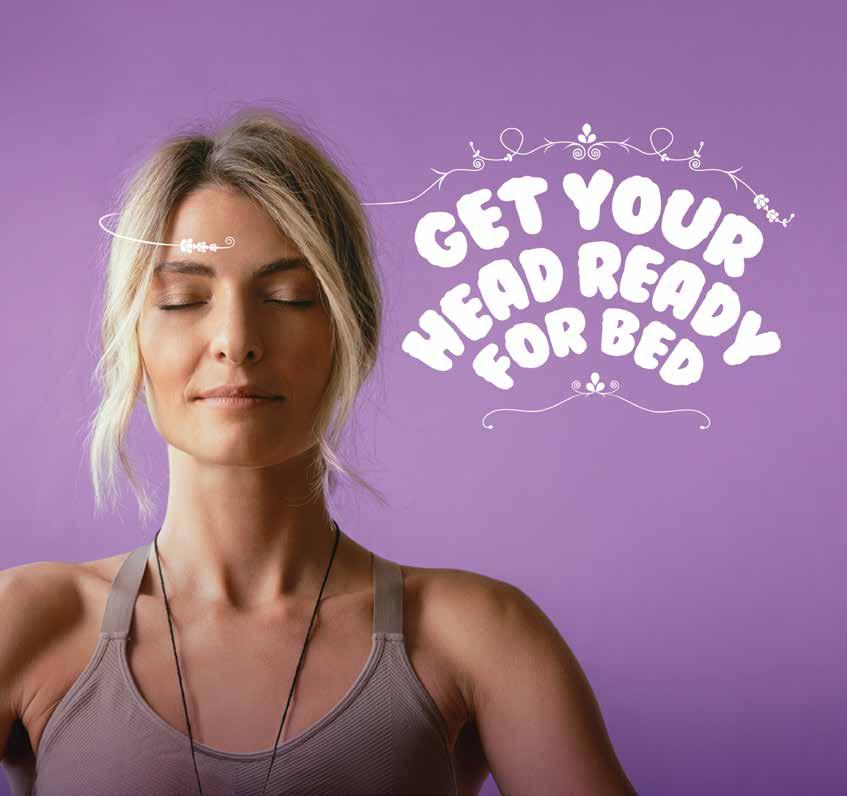
References: 1. Seremind consumer leaflet, September 2022. ® Seremind is a trade mark used under license from A. Menarini Australia Pty Ltd. Level 8, 67 Albert Avenue, Chatswood NSW 2067. ABN 62 116 935 758. Arrotex Pharmaceuticals, Cremorne VIC. ABN 30 605 552 234. All brand or product names mentioned are trademarks of their respective holders. Copyright © 2023. All rights reserved. CONSUMER-002338. Date of preparation: March 2023.
read the label and
Packaging and product images are for illustrative purposes and should be used as a guide only.
Always
follow the directions for use.
of
1,4,5 *Canesten Set: 6-12 months for the nail to grow back months CANESTEN SOL 6-12 months EXCILOR 6-12 months SCHOLL treatment time 12+ months 9-12 months 6-9 months 3-6 months TREATMENTS
Meet Our Team
Get to know the team at Blooms The Chemist Kenmore, QLD.

Jo
The best thing about working in Kenmore is the diverse range of customers that come into our store. We see new mums, regular customers… sometimes even celebrities.
Symantha
My favourite thing about this store is the supportive team I get to work with. Everyone’s friendly, but also helpful and provide great training opportunities.
Fei
In my role, my favourite thing is when customers come back happy, or when I hear that medicines have made a huge difference in their quality of life. I also love seeing that little spark of joy when customers come in and you acknowledge them by their first name. It’s extra nice when they aren’t expecting you to remember who they are!
Andy
My health tips aren’t a secret, but the hard part is doing them. Eat well, sleep as best you can, and exercise regularly.
Jodie
It’s so rewarding to help customers and offer genuine solutions – it’s a privilege to make a real impact on someone’s life.
38
What’s on at your Blooms The Chemist
Sleep Apnoea
One in four Australian adults are at risk of developing sleep apnoea. Sleep apnoea can affect anyone, though your risk is higher if you are obese, over 65 years of age, or have a family history of the condition. Symptoms can include snoring, constant irritability or falling asleep during the day.
An at-home sleep test can determine if you have sleep apnoea; ask your local Blooms The Chemist Pharmacist for more information on this condition and testing options.
Cholesterol Screening
The incidence of high cholesterol doubles from ages 45-54 and 55-64. If you're in this age group, you may be concerned about developing high cholesterol, and want to understand how you can implement lifestyle changes to safeguard your future health.
Your local Blooms The Chemist offers quick total cholesterol tests, with results in about three minutes. Your Pharmacist will talk you through your results and any recommended follow-up tests and lifestyle advice.
Ask your local Blooms The Chemist Pharmacist for more information about our range of health services.
To find your local Blooms The Chemist or shop online, head to
bloomsthechemist.com.au
HEALTH CHECK MAGAZINE | SPRING 2023 39
.com.au
bloomsthechemist










 BLOOMS THE CHEMIST KINGAROY
BLOOMS THE CHEMIST KINGAROY

































































